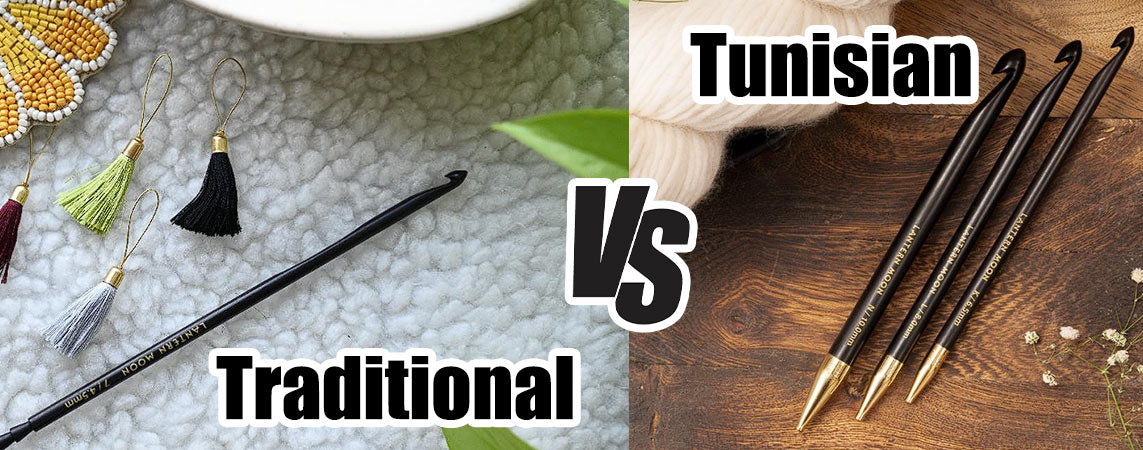
Crochet is a popular yarn craft that works for beautiful garments, accessories, home décor, Amigurumi, and other creative projects. All you need is yarn and single-ended crochet hooks. But there's more. Besides the regular or what can be better said as traditional crochet, we have the knit-crochet hybrid Tunisian crochet. Also known as Afghan crochet, the unique craft produces a fabric that looks like knitting, sometimes works like knitting (stitches on the hook), and also has names such as knit and purl stitches, which are similar to knitting but work with a crochet hook. Albeit, a special one- a crochet hook longer than traditional single-ended crochet hooks- interchangeable Tunisian crochet hooks. Tunisian crochet continues to be confused with knitting and crochet but is a best version of both.
However, one thing is clear: both forms are stand-alone fiber crafts with unique stitches and fabric. In this blog, we'll explore both regular and Tunisian crochet. Whether you are eager to tackle new challenges or are a complete newbie at crocheting, you can explore your creative expression with this guide.
Traditional Crochet vs Tunisian - What's the Difference?
Crocheting, traditional and Tunisian, is unique and very different. What remains common is that you hook the yarn, yarn over, and make loops of stitches.
Traditional Crochet

In regular crochet, you typically use a traditional single-ended crochet hook. One end has a hook for the loops, while the other has a handle that you hold in your hands. Stitches are worked one at a time and each stitch is completed before moving on to the next. The project is turned at the end of rows or worked in the round without turning for circular projects.
With this crochet form, you can create fabric varying widely from lacey and open to dense and warm, depending on the basic crochet stitches and techniques applied. You can explore projects ranging from garments, accessories, toys to home décor. Another point to note is that it’s easier to correct mistakes in this form.
Tunisian Crochet

Tunisian crochet requires a particular type of crochet hook, which is longer than a traditional hook. It can have a cord and stopper at the end to prevent stitches from slipping off. There are also double-ended Tunisian hooks for working in the round, which can be created by joining two hooks with a cord connector.
Unlike regular crochet, Tunisian crochet works like knitting. You keep multiple stitches on the hook and then work them out. Each row is worked in two parts: the forward pass, where stitches are picked up and kept on the hook, and the return pass, where stitches are worked off the hook. Here too you work with basic Tunisian crochet stitches.
The crocheted fabric is typically thicker and denser, with a unique woven-like appearance that resembles knit stitches. A point to note here is, it’s a bit challenging to correct mistakes in Tunisian crochet. The fabric ideal for projects like blankets, scarves, and wraps and warm garments.
Regular vs. Tunisian Crochet in a Glance
|
Regular Crochet |
Traditional Crochet |
|
|
Tools |
Single-ended crochet hook |
Interchangeable Tunisian hook, double ended crochet hook that you can make with a connector and cord |
|
Stitches |
Chain stitch (CH), Single crochet (SC), Half Double Crochet (HDC), Double crochet (DC), Treble crochet (TR) |
Tunisian Simple Stitch (TSS), Tunisian Knit (TKS), Tunisian Purl (TPS), Tunisian Full Stitch and many more |
|
Technique |
Completes each stitch before moving on; works in rows or rounds. |
Keeps multiple stitches on the hook; works in two rows - a forward and return pass. |
|
Fabric |
Varied textures, from lacey and open to dense and warm. |
Dense, woven-like fabric with less stretch. |
|
Texture |
Offers more flexibility in fabric texture and drape. |
Creates a unique, slightly stretchy fabric that's reversible. |
|
Project Examples |
Suitable for a wide range of projects, including garments, accessories, and decorative items. |
Suits thick, durable items like warm blankets, sturdy bags. |
What is easier- Regular or Tunisian Crochet?
The ease of learning both crochet forms can vary greatly depending on the individual learner's preferences, dexterity, and familiarity with yarn crafts. If you have mastered regular crochet you can adapt Tunisian crochet skills. And, if you became an expert of the Tunisian craft regular crochet is easy for you. Many knitters believe that it’s easy to master Tunisian crochet. For regular crochet it is believed that knitters that excel in Continental knitting style are quick to adapt to crocheting.
For most beginners, single-ended crochet might be easier to start with due to its simpler stitches, more straightforward techniques, and ease of correcting mistakes. That being said, crafters with a background in knitting might find Tunisian crochet's method intriguing and easier to grasp due to its similarities with knitting, the longer hooks, and multiple stitches.
Choosing which craft you learn depends on your preference and comfort with either crafts. Many fiber artists enjoy learning and using both techniques in their projects for their distinctive and unparalleled textures and fabric qualities.
So, whether you are working on traditional or Tunisian crochet, explore Lantern Moon crochet hooks handcrafted from ebony wood. Enjoy a smooth luxury finish that allows yarn to flow while the hook prevents fatigue, even when crocheting for hours. Explore standard sizes, the amazing Radiance Set of six single-ended crochet hooks, or the beautiful Bequest Set of nine interchangeable Tunisian crochet hooks.
